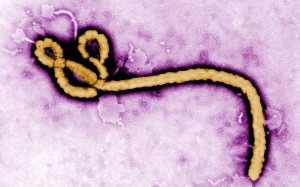It may seem like it was ages ago since the Ebola scare took the world by storm, but it was actually only two years ago. At the beginning of the outbreak, no one could pin down the cause of the virus and how it was being spread, it got to the point where anyone who showed symptoms of the virus were forced into quarantine. But after about a year, scientists think that they have been able to pin-point how exactly the virus initially began to spread throughout Africa. From several studies, they found that there have been mutations of the virus, leaving the less communicable diseases to die off.
The dying off of certain strands of the virus is a great example of the scientific principle of survival of the fittest. The original virus was found in wild animals and was then spread to humans, so it had to mutate in order to spread to humans and mutate further in order to spread more easily from person to person. This shows the survival of the fittest because it forces the virus to mutate or it will die off because it is not transmitted.
These mutations were originally found through the study of the human genome. They brought in blood samples from over 400 samples in order to compare their blood types in order to observe the affects the Ebola has on a person. A genome is the code that is made up of DNA that can be found in a persons 23 pairs of chromosomes. It is essentially the basis of how we are who we are individually. So because they were able to research the genomes of the four hundred patients, they were able to see what the viruses was attacking in the body. And when they found how the virus was affecting the genome, they were able to conclude how it was being spread.
Further studies showed that the second wave of the virus was much larger than the original introduction to humans. It was originally thought to be because there was a lot of passing the virus between Sierra Leone and Guinea, due to the fact that the first cases had sprung up in Guinea and then showed up in Sierra Leone. They then stated that the virus began to spread throughout the rest of the region without many influence from outside sources, but it was later hypothesized that the original Guinea strand was not fully treated and had slowly been spreading throughout the capital. This is a great example of what Andrew always emphasizes, that in science, you gain more knowledge because people question others’ work which creates more research and analysis.
Sources
http://www.telegraph.co.uk/news/worldnews/ebola/



I liked your blog post! I think that the Ebola scare was very short-lived fortunately. I also think that all of this talk about Zika might become like Ebola where people are anxious over it and then it disappears. Here is a link to an article on Zika.
http://www.globalresearch.ca/thwarting-the-zika-virus-threat-in-america-aerial-deployment-of-dangerous-pesticides/5545621